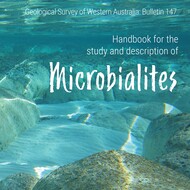Microbialites Handbook sets new standard for the study of these unique fossils
| Date: | Friday, 01 May 2020 |
|---|
A new publication summarising more than 50 years of geoscience research on Western Australia’s microbialites is setting a new standard for the study of some of Earth’s oldest fossils. Created by microbes, some of these fossils date back to the Archean period, around 3.5 billion years ago.
Eminent scientist and retired Chief Paleontologist from the Geological Survey of Western Australia (GSWA), Dr Kathleen Grey, worked with Professor Stanley Awramik from the University of California, Santa Barbara, to develop GSWA Bulletin 147 Handbook for the study and description of microbialites.
This handbook sets a benchmark for universal terminology and descriptive methodology for the study of microbialites, which includes stromatolites like those from the Shark Bay World Heritage site.
Dr Grey used the unique geology of Western Australia, which is known for its rich record of living and fossil microbialites, to study these life forms in conjunction with scientists from various disciplines. The handbook holds significance for researchers exploring early life here on Earth, and those working on modern examples.
Department of Mines, Industry Regulation and Safety Executive Director Geological Survey and Resource Strategy Jeff Haworth said this publication is a major release for GSWA and the research community.
“Due to our State’s wide expanses of geologically old rocks, it is considered one of the most important research areas on the origin and evolution of early life on Earth,” Mr Haworth said.
“This publication provides specialist geologists and paleontologists worldwide with field research tools and guidelines for the first time, which will influence and advance the study of these fascinating and distinctive formations for years to come.”
It is also of interest to the space exploration community because current theories suggest that if life ever existed on Mars, it would most likely resemble microbialites, some of the earliest forms of life on Earth. This is due to the similar early histories of both planets.
Back on Earth, microbialites have recently captured the attention of the petroleum industry because of large hydrocarbon accumulations hosted within fossil stromatolites discovered off the coasts of Brazil and Angola.
“The organisms that form microbialites are a known source of petroleum, but more recently have proved to be very efficient reservoirs, making them interesting indicators for petroleum exploration,” Mr Haworth said.
Dr Grey’s aim was to make this handbook as freely available as possible to researchers around the world to enable universal access to standardised information that would support consistent and comparable research of these unique and significant fossils.
GSWA Bulletin 147 Handbook for the study and description of Microbialites can be purchased as a casebound book for $130 and is also available for download as a free PDF from the DMIRS eBookshop.

